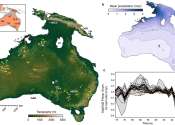New analysis explains formation of bulge on farside of moon
(PhysOrg.com) -- A bulge of elevated topography on the farside of the moon--known as the lunar farside highlands--has defied explanation for decades. But a new study led by researchers at the University of California, Santa ...









